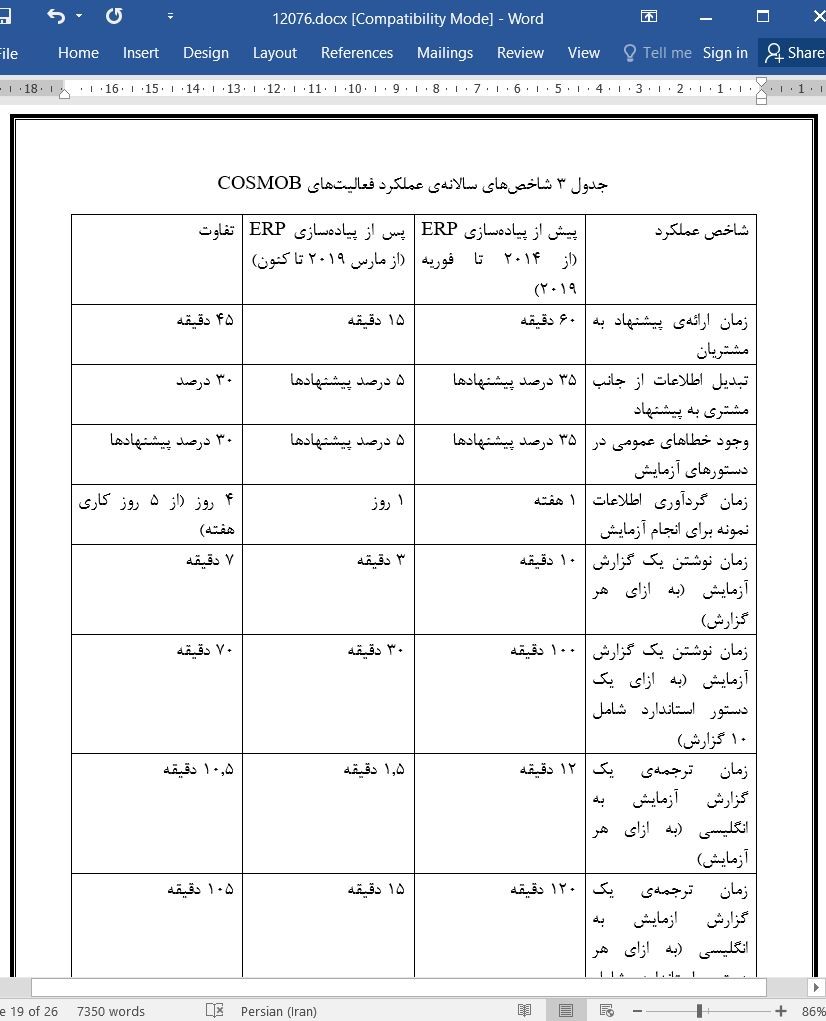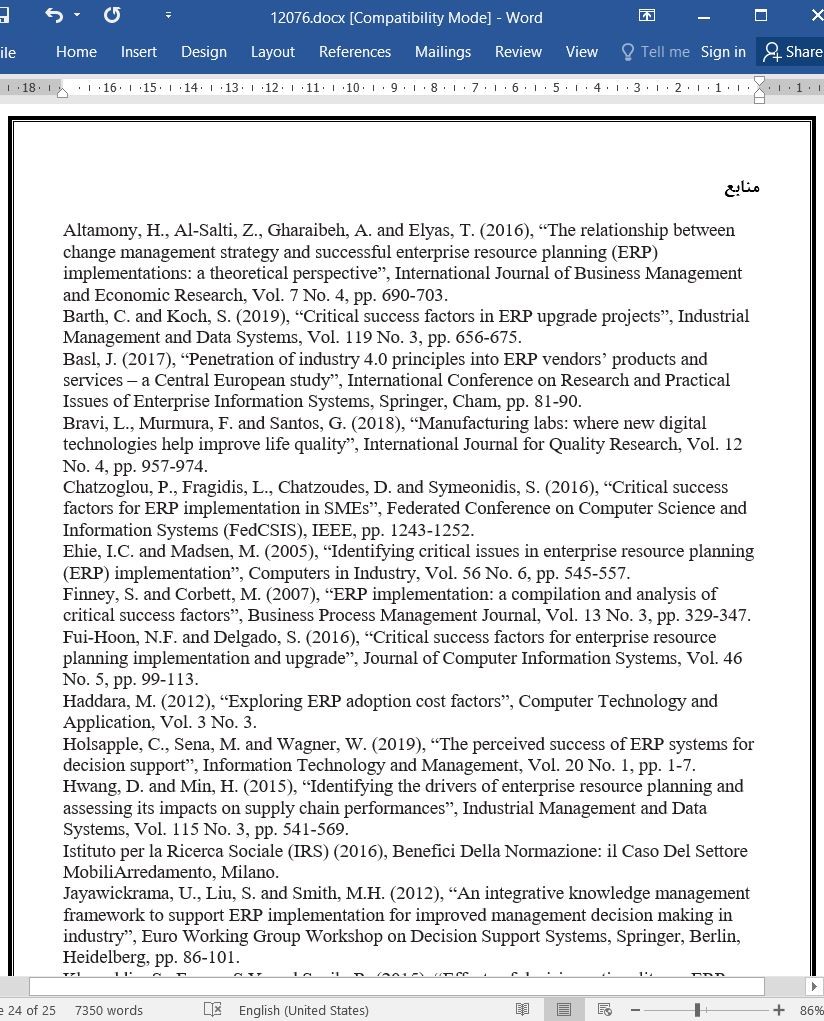
مزایا و معایب تدوین یک برنامه ریزی منابع سازمانی برای مدیریت کیفیت در یک نهاد معتبر
چکیده
هدف: پژوهش کنونی بر آن است که نوآوری های ارائه شده در زمینه ی برنامه ریزی منابع سازمانی را در بخش مبلمان چوبی ایتالیا و با تمرکز بر مطالعه ی موردی COSMOB واکاوی و تحلیل کند و بررسی نماید که چگونه این شرکت کوچک کوشیده است تا با بهره گیری از مزایای برآمده از عرضه ی فن آوری های دیجیتال نوین، رقابت خود در حوزه ی آزمایشگاه های معتبر و صلاحیت دار را در صنعت مبلمان حفظ کند.
طرح/روش/رویکرد: این پژوهش با رویکردی کیفی تدوین شده است. مطالعه ی حاضر یک توسعه ی مفهومی است و با استفاده از مصاحبه های تحقیقی یک مطالعه موردی از COSMOB طراحی می کند. این مطالعه ی موردی بر پایه-ی پشتیبانی بلندمدت پژوهشگر از مدیر کیفیت شرکت، و مصاحبه های متناوب دو ماه یکبار برای به روزرسانی بینش و دریافت آن ها پیرامون تکامل و توسعه ی فعالیت مربوط تدوین شده است.
یافته ها: نیاز به فرایندهای تصمیم گیری سریع، مدیریت حجم بالایی از داده ها، و نیاز به ارتباط بین سازمانی و درون سازمانی موجب گردید که شرکت نامبرده با خاطری آسوده تصمیم به اتخاذ نرم افزار یکپارچه بگیرد. درباره ی مهم-ترین مسائل مرتبط با اتخاذ و پذیرش آن، این مباحث عبارت بودند از: طول مدت پیاده سازی عملیات، پیچیدگی سامانه، و تطبیق پذیری محدود.
اصالت/ ارزش: ارزش این مقاله در آن است که این یک مطالعه ی موردی ژرف کاوانه از شرکت است که در آن پژوهشگر از پیاده سازی سامانه برای کل فعالیت پشتیبانی کرد، و به پیامد آن، یک مبنای کیفی از اطلاعات به دست آورد که از راه مصاحبه قابل دستیابی نیستند.
1. مقدمه
تکامل سامانه های اطلاعاتی دنباله روی تکامل فن آوری اطلاعات (IT) بوده است. اما تنها در دهه ی 1990 بود که سامانه های برنامه ریزی منابع سازمانی (ERP) نیز به عنوان ابزارهایی متداول برای مدیریت فرایندهای تجاری به شیوه-ای یکپارچه در کسب و کارهای کوچک و متوسط رواج یافتند (سیتاماراجو، 2015). گردآوری و پردازش اطلاعات در دهه های اخیر به یک عامل رقابتی بنیادین تبدیل شده است. اطلاعات نقشی مهم و حیاتی در سامانه ی تجاری ایفا می کند و سهم به سزایی در همه ی فرایندهایی که از مدیریت شرکت پشتیبانی می کنند، دارد. برخی پژوهش ها نشان داده اند که عملکرد شرکت و مزیت رقابتی به طور فزاینده ای با مؤلفه های ناملموسی همچون دارایی های اطلاعاتی، دانش افزایی و به اشتراک گذاری مرتبط هستند (مورابیتو، 2013). در این بافت، ابتکارات سیاسی به تدریج از شرکت ها برای گذار به اصطلاحاً «انقلاب صنعتی چهارم» پشتیبانی کردند (ویِر و همکاران، 2015). این اصطلاح به دیجیتالی-شدن فرایندهای تولید و گسترش هوش مصنوعی به کار رفته در اشیاء اشاره دارد. عناصر فن آورانه که در حال حاضر جهان صنعتی را دگرگون می کنند شامل اینترنت اشیاء، هوش مصنوعی، روباتیک و رایانش ابری هستند (لی و همکاران، 2015؛ براوی و همکاران، 2018؛ باسل، 2017).
Abstract
Purpose This study aims to analyze the innovations introduced, with reference to enterprise resource planning, in the Italian wood–furniture sector, focusing attention on the COSMOB S.p.A. case study, identifying how this small company tried to exploit the advantages offered by the introduction of new digital technologies to remain competitive in the context of the accredited Test Laboratories in the furniture industry.
Design/methodology/approach The research has been developed with a qualitative approach. The study is a conceptual development and it uses exploratory interviews to create a single case study of COSMOB. The case study was developed with the realization by the researcher of a long period of support to the company’s Quality Manager, and periodic bi-monthly interviews for an update of their perceptions on the development of the activity.
Findings The need for rapid decision-making processes, the management of high volumes of data and the need for inter- and intra-organizational connection had a critical relief in company’s decision to adopt the integrated software. As for the main problems related to its adoption, these were the duration of the implementation of the operation, the complexity of the system and its limited adaptability.
Originality/value The value of the paper relies on the development of an in-depth company case study, where the researcher supported the implementation of the system for the entire activity, obtaining therefore, a qualitative base of information that cannot be obtained through limited interviews.
1. Introduction
The evolution of information systems has followed that of information technology (IT). But it was not until the 1990s that enterprise resource planning (ERP) systems also became widespread in small- and medium-sized businesses as tools to manage business processes in an integrated manner (Seethamraju, 2015). The collection and processing of information has become, in recent decades, a fundamental competitive factor. Information plays a crucial role within the business system, providing an important contribution to all the processes that support corporate governance. Some studies have shown that corporate performance and competitive advantage are increasingly linked to intangible elements such as information assets and knowledge development and sharing (Morabito, 2013). In this context, political initiatives have begun to support companies in the transition to the so-called “Industry 4.0” (Weyer et al., 2015). This term refers to the digitalization of production processes and the diffusion of artificial intelligence embedded in objects. The technological elements that are currently transforming the industrial world are represented by the Internet of Things, artificial intelligence, robotics, cloud computing (Lee et al., 2015; Bravi et al., 2018; Basl, 2017).
چکیده
1. مقدمه
2. مروری بر پیشینه
1.2 انگیزه ها برای پذیرش برنامه ریزی منابع سازمانی
2.2 عوامل مهم موفقیت در برنامه ریزی منابع سازمانی و موانع پیش روی پذیرش
3.2 استفاده از برنامه ریزی منابع سازمانی در شرکت های کوچک و متوسط
3. روش شناسی
4. مطالعه موردی COSMOB
4.1 بخش مبلمان سازی چوبی و اطلاعاتی سازی
2.4 وجهه شرکت
3.4 مدیریت کیفیت در COSMOB
4.4 پذیرش سامانه ی برنامه ریزی های منابع سازمانی در COSMOB
5.4 دلایل پذیرش برنامه ریزی های منابع سازمانی و موانع مواجه شده
5. نتیجه گیری
منابع
Abstract
1. Introduction
2. Literature review
2.1 Drivers of enterprise resource planning adoption
2.2 Enterprise resource planning critical success factors and barriers of adoption
2.3 Use of enterprise resource plannings in small- and medium-sized enterprises
3. Methodology
4. COSMOB case study
4.1 Wood–furniture sector and its informatization
4.2 Company profile
4.3 Management of quality in COSMOB
4.4 Adoption of the enterprise resource plannings system in COSMOB
4.5 Reasons behind the adoption of the enterprise resource plannings and the barriers encountered
5. Conclusions
References
- اصل مقاله انگلیسی با فرمت ورد (word) با قابلیت ویرایش
- ترجمه فارسی مقاله با فرمت ورد (word) با قابلیت ویرایش، بدون آرم سایت ای ترجمه
- ترجمه فارسی مقاله با فرمت pdf، بدون آرم سایت ای ترجمه



